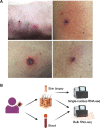Bulk and single-nucleus RNA sequencing highlight immune pathways induced in individuals during an Ixodes scapularis tick bite
- PMID: 37846980
- PMCID: PMC10652856
- DOI: 10.1128/iai.00282-23
Bulk and single-nucleus RNA sequencing highlight immune pathways induced in individuals during an Ixodes scapularis tick bite
Abstract
Ticks are hematophagous arthropods that use a complex mixture of salivary proteins to evade host defenses while taking a blood meal. Little is known about the immunological and physiological consequences of tick feeding on humans. Here, we performed the first bulk and single-nucleus RNA sequencing (snRNA-seq) of skin and blood of four persons presenting with naturally acquired, attached Ixodes scapularis ticks. Pathways and individual genes associated with innate and adaptive immunity were identified based on bulk RNA sequencing, including interleukin-17 signaling and platelet activation pathways at the site of tick attachment or in peripheral blood. snRNA-seq further revealed that the Hippo signaling, cell adhesion, and axon guidance pathways were involved in the response to an I. scapularis bite in humans. Features of the host response in these individuals also overlapped with that of laboratory guinea pigs exposed to I. scapularis and which acquired resistance to ticks. These findings offer novel insights for the development of new biomarkers for I. scapularis exposure and anti-tick vaccines for human use.
Keywords: RNA-seq; acquired resistance; human; immune pathways; tick; tick-borne pathogens.
Conflict of interest statement
The authors declare no conflict of interest.
Figures



Similar articles
-
Salp14 epitope-based mRNA vaccination induces early recognition of a tick bite.Vaccine. 2024 Oct 24;42(24):126304. doi: 10.1016/j.vaccine.2024.126304. Epub 2024 Sep 5. Vaccine. 2024. PMID: 39236403
-
SALP16, a gene induced in Ixodes scapularis salivary glands during tick feeding.Am J Trop Med Hyg. 2000 Jan;62(1):99-105. doi: 10.4269/ajtmh.2000.62.99. Am J Trop Med Hyg. 2000. PMID: 10761732
-
Host-specific expression of Ixodes scapularis salivary genes.Ticks Tick Borne Dis. 2019 Feb;10(2):386-397. doi: 10.1016/j.ttbdis.2018.12.001. Epub 2018 Dec 3. Ticks Tick Borne Dis. 2019. PMID: 30545615
-
Immunity-related genes in Ixodes scapularis--perspectives from genome information.Front Cell Infect Microbiol. 2014 Aug 22;4:116. doi: 10.3389/fcimb.2014.00116. eCollection 2014. Front Cell Infect Microbiol. 2014. PMID: 25202684 Free PMC article. Review.
-
A longitudinal transcriptomic analysis from unfed to post-engorgement midguts of adult female Ixodes scapularis.Sci Rep. 2023 Jul 13;13(1):11360. doi: 10.1038/s41598-023-38207-5. Sci Rep. 2023. PMID: 37443274 Free PMC article. Review.
Cited by
-
Peromyscus leucopus, Mus musculus, and humans have distinct transcriptomic responses to larval Ixodes scapularis bites.Infect Immun. 2025 Apr 8;93(4):e0006525. doi: 10.1128/iai.00065-25. Epub 2025 Mar 11. Infect Immun. 2025. PMID: 40066985 Free PMC article.
-
Salp14 epitope-based mRNA vaccination induces early recognition of a tick bite.Vaccine. 2024 Oct 24;42(24):126304. doi: 10.1016/j.vaccine.2024.126304. Epub 2024 Sep 5. Vaccine. 2024. PMID: 39236403
References
-
- Sajid A, Matias J, Arora G, Kurokawa C, DePonte K, Tang X, Lynn G, Wu M-J, Pal U, Strank NO, Pardi N, Narasimhan S, Weissman D, Fikrig E. 2021. mRNA vaccination induces tick resistance and prevents transmission of the lyme disease agent. Sci Transl Med 13:eabj9827. doi: 10.1126/scitranslmed.abj9827 - DOI - PubMed
Publication types
MeSH terms
Substances
Grants and funding
LinkOut - more resources
Full Text Sources
Medical
Molecular Biology Databases

